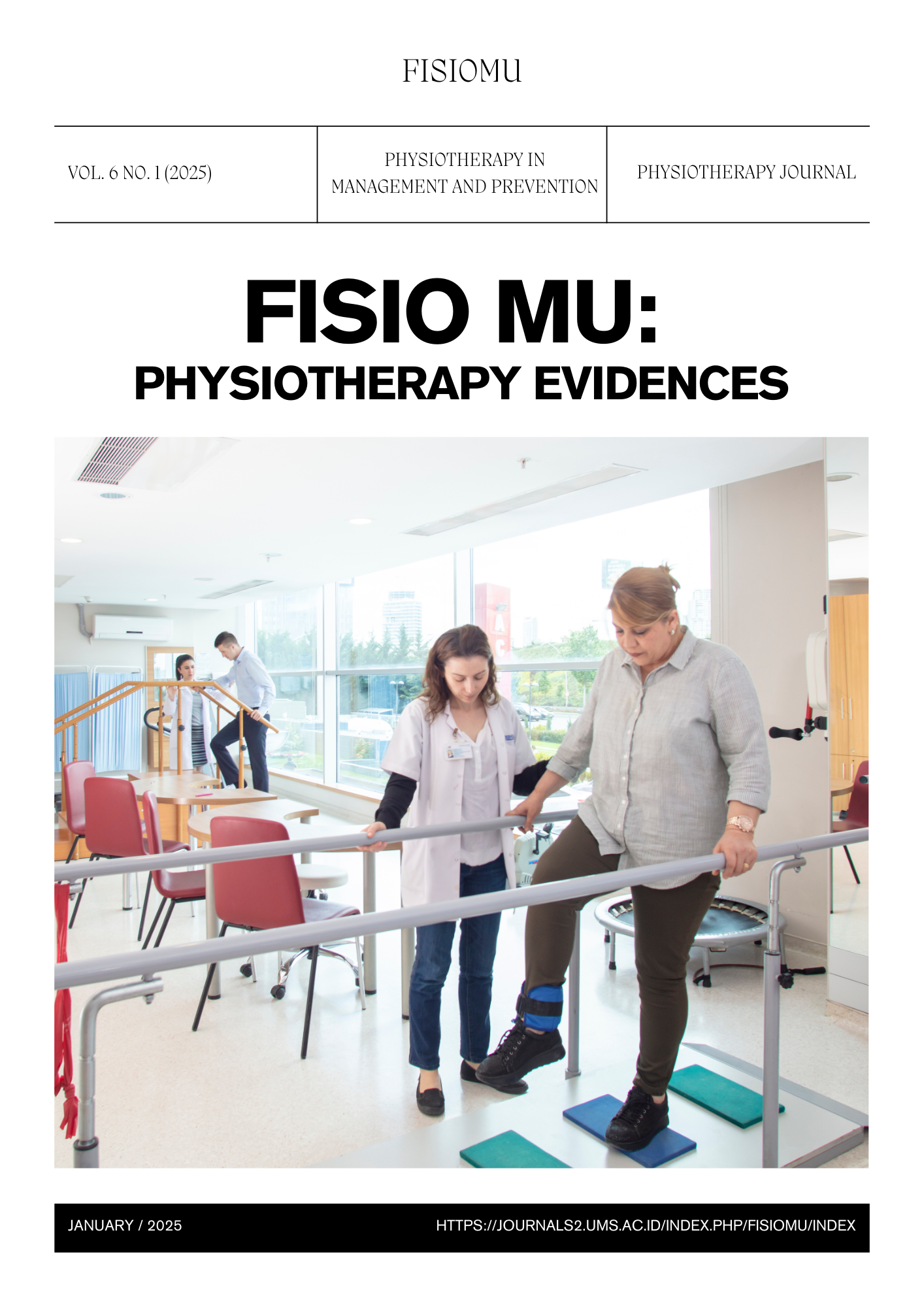Integration of Ergonomic Intervention and Motor Control Exercises to Improve Work Posture and Reduce Musculoskeletal Complaints in Stone Crusher Workers
DOI:
https://doi.org/10.23917/fisiomu.v6i1.6667Abstract
Introduction: The incidence of musculoskeletal disorders in industrial workers who rely on manual material handling was found to be 100%. Uncontrolled exposure to risk factors in the workplace will cause the cumulative effect of repetitive strain injury so that musculoskeletal disorders become progressive and chronic and have the potential to cause disability, drug abuse, absenteeism, and cost expenditure. This study aimed to examine the effect of integrating ergonomic interventions and motor control exercises to improve work posture and reduce musculoskeletal disorders in stone crusher workers. Methods: This study was a randomized controlled trial design with two groups, a control group, and a treatment group. The study respondents were selected randomly, each group consisting of 21 respondents. The control group intervention consisted of conventional physiotherapy actions: Portable Transcutaneous Electrical Nerve Stimulation (TENS) treatment modalities, Portable Ultrasound (US), passive joint mobilization, and passive stretching. The treatment group intervention is called the ergo movement system which consists of the stages of risk assessment, risk control-task adaptation, and motor exercise. The data assessed included work posture assessment using the Rapid Entire Body Assessment (REBA) instrument and musculoskeletal complaints using the Nordic Body Map instrument. Data measurements were conducted before the intervention and 4 weeks after the intervention. Results: The control group intervention statistically only had a significant impact on reducing musculoskeletal complaints 0.01<0.05 but had no impact on improving work posture 0.83>0.05. Meanwhile, the treatment group intervention significantly affected improving work posture 0.01<0.05 and reducing musculoskeletal complaints 0.01<0.05. Conclusion: The ergo movement system intervention was significantly more effective than conventional physiotherapy intervention in overcoming problems related to occupational health.
Downloads
References
Moradi B, Barakat S. The association of manual load lifting tasks with the ergonomic risk factors of musculoskeletal disorders. J Hum Environ Heal Promot. 2020;6(4):183–7.
Harari Y, Bechar A, Riemer R. Workers’ biomechanical loads and kinematics during multiple-task manual material handling. Appl Ergon. 2020;83:102985. DOI: https://doi.org/10.1016/j.apergo.2019.102985
Wicaksono U, Muliarta IM, Adiputra LMISH. Reducing cts complaints and the fatigue of rock breaker through ergonomics approach by exercising nerve-tendon mobilization and short break. Eduvest-Journal Univers Stud. 2021;1(10):1141–51. DOI: https://doi.org/10.59188/eduvest.v1i10.242
Wicaksono U, Prayogo D, Sadu B. Application of physiotherapy to occupational health and ergonomics issues in stone-breaker employees. J eduhealth. 2022;13(02):577–81.
Mallapiang F, Muis M. The relationship of posture working with musculoskeletal disorders (MSDs) in the weaver West Sulawesi Indonesia. Gac Sanit. 2021;35(1):S15–8. DOI: https://doi.org/10.1016/j.gaceta.2020.12.005
Demissie B, Bayih ET, Demmelash AA. A systematic review of work-related musculoskeletal disorders and risk factors among computer users. Heliyon. 2024;10(3):e25075. DOI: https://doi.org/10.1016/j.heliyon.2024.e25075
Purba IG, Lestari M. Faktor risiko keluhan musculoskeletal disorders (MSDS) pada aktivitas pengangkutan beras di PT Buyung Poetra Pangan Pegayut Ogan Ilir. J Ilmu Kesehat Masy. 2017;8(2):125–34. DOI: https://doi.org/10.26553/jikm.2016.8.2.125-134
So B, Szeto G, Lau R, Dai J, Tsang S. Effects of ergomotor intervention on improving occupational health in workers with work-related neck-shoulder pain. Int J Environ Res Public Health. 2019;16(24):5005. DOI: https://doi.org/10.3390/ijerph16245005
Van Eerd D, Munhall C, Irvin E, Rempel D, Brewer S, van der Beek A, et al. Effectiveness of workplace interventions in the prevention of upper extremity musculoskeletal disorders and symptoms: an update of the evidence. Occup Environ Med. 2016;73(1):62–70. DOI: https://doi.org/10.1136/oemed-2015-102992
Boschman J, van der Molen H, Sluiter J, Frings-Dresen M. Musculoskeletal disorders among construction workers: a one-year follow-up study. BMC Musculoskelet Disord. 2012;13(196):1–10. DOI: https://doi.org/10.1186/1471-2474-13-196
Tsang S, So B, Lau R, Dai J, Szeto G. Effects of combining ergonomic interventions and motor control exercises on muscle activity and kinematics in people with work-related neck–shoulder pain. Eur J Appl Physiol. 2018;118:751–65. DOI: https://doi.org/10.1007/s00421-018-3802-6
Kim JY, Kwag K Il. Clinical effects of deep cervical flexor muscle activation in patients with chronic neck pain. J Phys Ther Sci. 2016;28(1):269–73. DOI: https://doi.org/10.1589/jpts.28.269
Bazazan A, Dianat I, Feizollahi N, Mombeini Z, Shirazi AM, Castellucci HI. Effect of a posture correction–based intervention on musculoskeletal symptoms and fatigue among control room operators. Appl Ergon. 2019;76:12–9. DOI: https://doi.org/10.1016/j.apergo.2018.11.008
Karimi A, Dianat I, Barkhordari A, Yusefzade I, Rohani-Rasaf M. A multicomponent ergonomic intervention involving individual and organisational changes for improving musculoskeletal outcomes and exposure risks among dairy workers. Appl Ergon. 2020;88:103159. DOI: https://doi.org/10.1016/j.apergo.2020.103159
Tsang S, So B, Lau R, Dai J, Szeto G. Comparing the effectiveness of integrating ergonomics and motor control to conventional treatment for pain and functional recovery of work‐related neck–shoulder pain: A randomized trial. Eur J Pain. 2019;23(6):1141–52. DOI: https://doi.org/10.1002/ejp.1381
Daryono, Sutjana IDP, Muliarta IM. Redesain rakel dan pemberian peregangan aktif menurunkan beban kerja dan keluhan muskuloskeletal serta meningkatkan produktivitas kerja pekerja sablon pada industri sablon Surya Bali di Denpasar. J Ergon Indones. 2016;2(2):15–26. DOI: https://doi.org/10.24843/JEI.2016.v02.i02.p02
Damantalm Y, Tirtayasa K, Adiatmika IPG, Manuaba IBA, Sutjana IDP, Sudiajeng L. Pemberian buah pisang, istirahat pendek dan peregangan menurunkan keluhan muskuloskeletal, kelelahan dan meningkatkan produktivitas pemanen pengguna alat egrek perkebunan kelapa sawit PT SSD Kalimantan Timur. J Ergon Indones. 2018;4(1):47–56. DOI: https://doi.org/10.24843/JEI.2018.v04.i01.p04
Ferdyastari N, Adiatmika IPG, Purnawati S. Workstation improvement dan pemberian stretching karyawan pembersihan injeksi menurunkan kebosanan kerja, keluhan muskuloskeletal, dan meningkatkan produktivitas pada industri perak di CV JPS. J Ergon Indones. 2018;4(1):18–27. DOI: https://doi.org/10.24843/JEI.2018.v04.i01.p03
Alwi I. Kriteria empirik dalam menentukan ukuran sampel pada pengujian hipotesis statistika dan analisis butir. Form J Ilm Pendidik MIPA. 2015;2(2):140–8. DOI: https://doi.org/10.30998/formatif.v2i2.95
Blau FD, Kahn LM. The gender wage gap: extent, t rends, and explanations. J Econ Lit. 2017;55(3):789–865. DOI: https://doi.org/10.1257/jel.20160995
Republik Indonesia. Undang-undang tentang ketenagakerjaan nomor 13. 2003.
Judge TA, Robbins SP. Essentials of organizational behavior. Pearson Education (us); 2017.
Wicaksono U. Latihan mobilisasi saraf dan tendon serta istirahat pendek melalui pendekatan ergonomi dapat menurunkan keluhan carpal tunnel syndrome dan kelelahan pada pekerja pemecah batu. Universitas Udayana; 2021.
Vitalistyawati LPA, Sari N. Core Stability Exercise Dapat Menurunkan Nyeri Punggung Bawah Dan Meningkatkan Daya Tahan Otot Lumbal Pada Pekerja Penjahit. J Fisioter dan Rehabil. 2024 Sep;9(1).
Atya AM, Mansour WT. Laser versus nerve and tendon gliding exercise in treating carpal tunnel syndrome. Life Sci J. 2011;8(2):413–20.
Muliarta IM, Adiputra IN, Dinata IMK, Adiputra LMISH, Tunas IK. Active stretching and working posture correction to improve psycho-physiological response among computer operators for high school students. J Hum Ergol (Tokyo). 2020;49(1):9–16.
Nooryana S, Adiatmika IPG, Purnawati S. Latihan peregangan dinamis dan istirahat aktif menurunkan keluhan muskuloskeletal pada pekerja di industri garmen. J Ergon Indones. 2020;6(1):61–7. DOI: https://doi.org/10.24843/JEI.2020.v06.i01.p08
Shah J, Tanwar T, Iram I, Aldabbas M, Veqar Z. Effect of increased lumbar lordosis on lumbar multifidus and longissimus thoracis activation during quadruped exercise in patients with chronic low back pain: an emg study. J Appl Biomech. 2020;36(6):436–43. DOI: https://doi.org/10.1123/jab.2020-0040
Nandlall N, Rivaz H, Rizk A, Frenette S, Boily M, Fortin M. The effect of low back pain and lower limb injury on lumbar multifidus muscle morphology and function in university soccer players. BMC Musculoskelet Disord. 2020;21(1):1–10. DOI: https://doi.org/10.1186/s12891-020-3119-6
Ekstrom RA, Donatelli RA, Carp KC. Electromyographic analysis of core trunk, hip, and thigh muscles during 9 rehabilitation exercises. J Orthop Sport Phys Ther. 2007;37(12):754–62. DOI: https://doi.org/10.2519/jospt.2007.2471
Putri F, Adiatmika IPG, Dinata IMK. Improvement Of Working Condition Through A Participatory Ergonomics Approach Decrease Low Back Pain Complaints And Increase The Productivity Of Tailors. Eduvest-Journal Univers Stud. 2021;1(10):1–152. DOI: https://doi.org/10.59188/eduvest.v1i10.241
Downloads
Submitted
Accepted
Published
How to Cite
Issue
Section
License
Copyright (c) 2024 Fisio Mu : Physiotherapy Evidaces Journal

This work is licensed under a Creative Commons Attribution-NonCommercial-NoDerivatives 4.0 International License.

This work is licensed under a Creative Commons Attribution-NonCommercial 4.0 International License.
Authors who publish with FISIO MU: Phsiotherapy Evidences agree to the following terms:
- Author(s) retain copyright and grant the journal right of first publication with the work simultaneously licensed under a Creative Commons Attribution-NonCommercial 4.0 International License that allow others to share the work within an acknowledgement of the work’s authorship and initial publication of this journal.
- Author(s) are able to enter into separate, additional contractual arrangement for the non-exclusive distribution of the the journal’s published version of the work (e.g. acknowledgement of its initial publication in this journal).
- Author(s) are permitted and encouraged to post their work online (e.g. in institutional repositories or on their websites) prior to and during the submission process, as it can lead to productive exchanges, as well as earlier and greater citation of published works.












